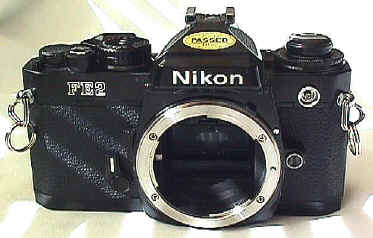Nikon FE with Nikkor 50mm f/1.4 lens Overview Maker Type Lens Sensor/medium 36 mm × 24 mm ISO 12 – 4000 Film advance manual Focusing Focus Manual Exposure/metering Exposure modes, manual with Centerweighted Flash ISO standard 1/125 s Shutter range 8 s – 1/1000 s; Bulb; 1/90 s mechanical backup General Optional data backs MF-12 Optional MD-11, MD-12 142 × 57.5 × 89.5 mm 590 g (21 oz) Released 1978 The Nikon FE is an advanced semi-professional level, interchangeable lens,, (SLR). It was manufactured by in from 1978 to 1983, and was available new from dealer stock until c. The FE uses a metal-bladed, vertical-travel with a speed range of 8 to 1/1000 second, plus Bulb, and flash X-sync of 1/125th second. It had dimensions of 89.5 millimetres (3.52 in) height, 142 mm (5.6 in) width, 57.5 mm (2.26 in) depth and 590 grams (21 oz) weight. It was available in two colors: black with chrome trim and all black.


As on the FM, its model designation did not appear on the front of the camera, but was engraved as a small 'FE' preceding the serial number on the rear of the housing. Contents • • • • • • History [ ] The FE was the replacement for of 1977 and is a member of the classic Nikon compact F-series. The king of fighters 2002 unlimited match ps2 iso game download.
Nikon FM2 A Nikon FM2 in black finish The Nikon FM2 is an advanced. FM2n (for 'new' due to the N preceding the serial number on the rear of the top plate) althou. Lines', which became the number one song of the year in several countries. Which resulted in the chart-topping singles 'Radioactive' and 'Demons'.
It uses a rugged copper aluminum alloy chassis developed from the one introduced in the in 1977, with minor external controls and cosmetic differences. The Nikon compact F-series SLRs were moderately priced, semi-professional level stablemates to the company's premium-priced, professional level (1971) and (1980) SLRs. They were all-new successors to the F and EL-series of amateur level SLRs. With their quality construction, impressive durability and evolutionary technical innovation, the F-series were very popular with professional photographers, who prized their durability and ability to operate in extreme environments.
The FM/FE chassis proved to be remarkably long-lived. Nikon used it, with incremental improvements, as the backbone of the compact F-series from 1977 to 2006.
The other members of the compact F-series are the (introduced in 1982), (1983), (1983) and the limited production (2001). The FE was discontinued with the introduction of the visually similar FE2, which had faster top and sync shutter speeds, as well as TTL (through-the-lens) flash metering, but which was no longer compatible with non-AI lenses. Features [ ]. Nikon FE top plate showing the film-speed and exposure compensation dials on the left, and shutter speed dial on the right. The FE is a manual-focus SLR with manual exposure control or aperture-priority autoexposure, and electromechanical components. As such, the FE requires batteries (two S76 or A76, or or SR44, or one 1/3N) to power its electronically controlled shutter.
The batteries also power the FE's 'match-needle' exposure control system. This consists of two needles pointing along a vertical shutter speed scale on the left side of the viewfinder. In manual mode, a black needle points out the shutter speed recommended by the built-in, open aperture, through-the-lens (TTL), silicon photodiode (SPD), with 60/40 percent centerweighting, while a translucent green needle shows the actual camera-set shutter speed. The photographer adjusts the shutter speed and/or the lens aperture f-stop until the needles align. Viewfinder of the Nikon FE showing the ADR (Aperture Direct Readout) on top and the match needle exposure indicator on the left. In automatic mode, the FE's black needle indicates the shutter speed automatically set by the electronic circuitry in response to the light reaching the meter.